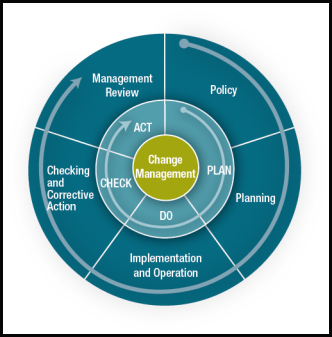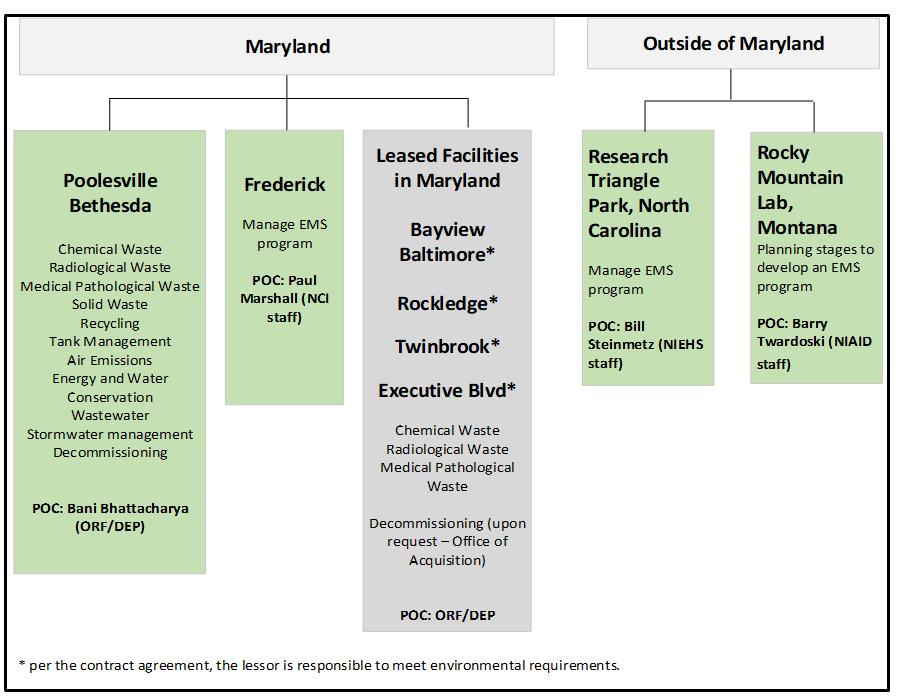An environmental management system (EMS) is the process used by
 organization to manage, review, correct, and improve the environmental aspects of its operations. The NIH Environmental Management System (NEMS) is a specialized EMS fit to the specific needs of the NIH. This program provides the framework for reducing the environmental impacts of NIH activities, while also supporting the NIH Mission.
organization to manage, review, correct, and improve the environmental aspects of its operations. The NIH Environmental Management System (NEMS) is a specialized EMS fit to the specific needs of the NIH. This program provides the framework for reducing the environmental impacts of NIH activities, while also supporting the NIH Mission.
Operations at the NIH encompass a wide range of duties, from bench-top lab work and office work to clinical center work, animal cage washing, landscaping, maintenance work, power plant operations and much more. This large cast of activities results in a very complex web of interactions with the environment. The NEMS plays a role in managing each of these many activities at the NIH to ensure minimized environmental impact and maximized operational efficiency.
The foundation of the NEMS is built on the daily actions of NIH employees.
With over 20,000 staff, the NIH has a great opportunity to positively impact the environment. Through education and awareness, the NEMS empowers individual employees to make environmentally friendly decisions in their day-to-day activities. The adoption of an environment-first culture is a major step towards increasing the sustainability of the NIH as a whole.
The NEMS also supports a myriad of programs that enable NIH staff to participate in environmental initiatives. Here are a few examples of these programs:
- The NIH Green Labs Program
- The “Green Your Move” Program
- Outreach Events, like Earth Day and the Green Labs Fair
- Environmental Meeting Groups, like the Green Team Leads
- Council and Sustainable Lab Practices Group
- Environmental Communications, like the NIH Green Zone Newsletter
For more information on the NEMS, please consult the
NEMS Websites. These sites provide an in-depth look at the NEMS and its many components.
History
The NEMS was created following the mandate of Executive Order (EO) 13148 (Greening the Government through Leadership in Environmental Management) by President Clinton in 2000. This EO established a 5-year EMS implementation goal for all Federal Facilities. The mandates from Executive Orders have changed multiple times since, first in 2007, when President Bush signed EO 13423 (Strengthening Federal Environmental, Energy, and Transportation Management) to revoke the previous EO, but expanding the government’s commitment to sustainability goals and renewing the EMS requirement. In October of 2009, President Obama signed Executive Order (EO) 13514 (Federal Leadership in Environmental, Energy, and Economic Performance), committing the Federal government to take a leadership role in promoting sustainability and responding to climate change. In part, EO 13514 required each agency to develop a Strategic Sustainability Performance Plan (SSPP) with sustainability goals and targets, including energy and greenhouse gas reduction targets.
As part of the Federal government’s commitment to lead by example in curbing the greenhouse gas (GHG) emissions that are driving climate change, President Obama signed EO 13693 (Planning for Federal Sustainability in the Next Decade) in February of 2015. The current mandate was established in May of 2018 by President Trump with EO 13834 (Efficient Federal Operations). This EO established that agencies must meet statutory requirements related to the energy and environmental performance of facilities, vehicles, and overall operations. This mandate seeks to increase efficiency, optimize performance, eliminate the unnecessary use of resources, reduce waste, cut cost, and protect the environment.
Structure
The NEMS conforms with all requirements of the ISO 14001: 2015 standard. This standard employs the Plan-Do-Check-Act (PDCA) model, which calls for a continuous cycle of making programmatic improvements, evaluating the effectiveness of these changes and establishing needed corrective actions. This process ensures the NEMS is steadily improving in an effort to better suit the environmental requirements of the NIH

NEMS REVIEW CHART
The inner circle is titled "Change Management."
The next circle has an arrow starting with PLAN, then DO, then CHECK and ending with ACT.
The outer circle has an arrow starting with Policy, then Planning, then Implementation and Operation,
then Checking and Corrective Action, and ending with Management Review.
Locations
The NEMS applies to every NIH campus and leased space. However, due to differences in local regulations and lessor requirements, the implementation of the NEMS varies between locations. A specialized EMS has been created for the Research Triangle Park, Rocky Mountain Labs, Frederick and Bethesda/Poolesville campuses. Leased facilities have environmental requirements set by the lessor. Please consult the chart below to determine the POC for the EMS at your location.
NEMS Point of Contact by Campus:

Questions & Comments
Please send any questions or comments to green@od.nih.gov or to the NEMS Program Manager, Ms. Bani Bhattacharya.
Captions o Alt
A photograph of the NIH Stream as it flows through the Bethesda campus.
This review chart shows three circles: The inner circle is titled "Change Management." The next circle has an arrow starting with PLAN, then DO, then CHECK and ending with ACT. The outer circle has an arrow starting with Policy, then Planning, then Implementation and Operation, then Checking and Corrective Action, and ending with Management Review.
This chart lists the point of contact for the NEMS program on each NIH campus or location. Maryland is split into three locations: Poolesville/Bethesda, Frederick and Leased Facilities. For the Poolesville/Bethesda campuses, contact Bani Bhattacharya. For the Frederick campus, contact Paul Marshall. For Leased Facilities, contact the Division of Environmental Protection for more information. The locations outside of Maryland are split into two categories: Research Triangle Park and Rocky Mountain Labs. For Research Triangle Park, contact Bill Steinmetz. For Rocky Mountain Labs, contact Barry Twardoski.